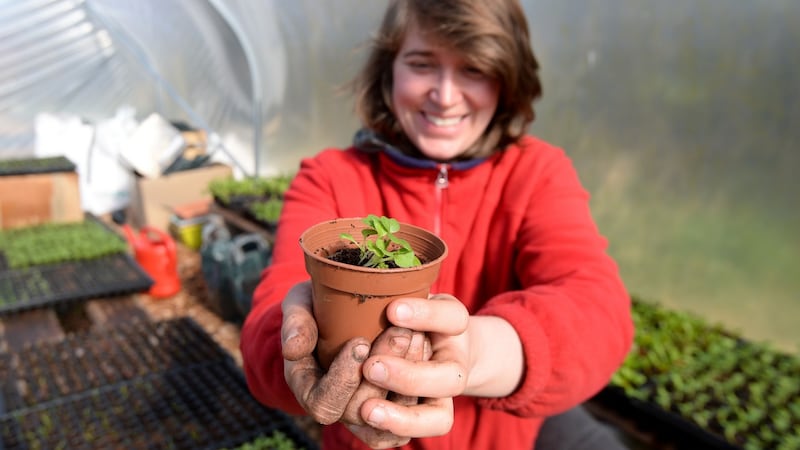There’s been a “little crisp edge of frost” on the plants in Katherine O’Hanlon’s poly tunnel this morning. But feathery March ice in Co Meath is nothing to the frosts the 30-year-old vegetable farmer experienced farming in upstate New York.
Jackdaw Farm is a two-acre smallholding in the village of Dromone. Kat and her husband Danny bought the house with its barn and hilly field behind it almost a year ago. They looked at sites in Co Louth and found everything too pricey, even the wrecks with barely any land. But this corner house which used to be a shop in the village feels completely right.
“I feel like every time I meet someone they’re like ‘oh I grew up in your home’. And I think ‘Did everybody grow up here? How many kids did they have?’ or they got their hair cut there or they used to use the shop.”
She’s put a sign in her front window with her mobile phone number, urging any neighbours who need help to contact her.
Pandemic fears and social distancing have been bringing people together in her corner of rural Ireland.
“Since this has happened I’m talking to more neighbours. I’m getting more messages about plants ... there’s more people going out for walks, so when I’m on my walk with our dog I see more people and we get chatting across the road from each other.
“In a weird way it’s pushed us apart because of this pandemic but I do feel like we’re starting to pay attention to each other a little more and to where our food is coming from as well. I’m just so curious to see how it plays out.”
Timber squares
Seed potatoes are planted in bags around the edge of her polytunnel with its covering of wood chippings surrounding the timber squares of “no dig” beds. One of them contains perfect sprigs of what look like grass. These are scallions Kat has grown from seed.
"They're so cute," she agrees when I suggest they're perfect for Instagram. "That's kind of the name of the game. A lot of the stuff here is very Instagram friendly."
So what does no-dig gardening mean?
“Essentially you’re just layering compost on top of the soil and not actually disturbing the soil structure underneath.”

Originally she went no dig because she couldn't afford a tractor. YouTube videos by Charles Dowding, the guru of no-dig, inspired the wooden frames.
Outside a large stretch of field is covered with thick black plastic hessian. Instead of heavy digging to turn the tufty grass into bare soil the plastic mulches down the grass and a thick layer of compost will be laid on top. Then in holes in the plastic Kat will plant onions and other alliums and beets and chard for summer cropping.
As a no-dig, no spray grower how does she fight off the slugs intent on savaging her tender mizunas and mibunas?
“I pick them off at night with a torch. I’ve heard various remedies, but I just thought if I go out and lay eggshells, or orange peels or coffee grounds or beer I might just as well go out and pick them off.”
So how does she despatch them?
“I don’t actually kill them. I just take them in a bucket and walk them to the very front of the house or our compost pile.”
She has read somewhere that slugs have a 20 foot “homing instinct” but she does suspect sometimes she is picking off the same slugs every night.
Cover its costs
Kat met Danny while woofing or working as a volunteer on an organic farm. His full-time job at Paypal in Dundalk enables her to work fulltime on the farm. This year it will just cover its costs. Next year she hopes to make maybe €2,000 "which sounds so ridiculous, but I think if you start small and grow slowly, if all I'm doing is growing my own food, then you don't get so disappointed when it doesn't work out."
Very often it doesn’t work out. Three of the farms she worked on in the US were all sold as their owners were forced to give up their efforts to make a living growing vegetables.
She grew root vegetables when she first leased land to farm, but the return on her efforts is so minuscule. What does she think of how supermarkets price vegetables?
“I feel like it’s giving people a warped idea of what the value of these things are. A lot of time the grocery stores will order bulk produce and then sell it to people at a loss with the idea that ‘oh they’ll pick up cookies and shampoo and crisps’ and so it compounds that effect.
“So the farmers who are growing on that scale for these big supermarkets they still get the money they need but for someone like me then it makes me look like doubly expensive. I always feel like I’m not trying to get rich. I’m just trying to make a living.”
Her market customers are not especially wealthy. Many of them are immigrants who miss the freshness of produce they remember from home.
She has felt a little guilty in past weeks as lives were upended and hers stayed pretty much the same. Many of the new people coming into this movement of farming are young women. She regular pairs up at markets with her friend Holly who sells milk and eggs from her dairy in Ardee.
“And I just keep meeting more women. For me I love it. I was a waitress before this. I’ve always had really physical jobs, and I do enjoy moving around, being on my feet all day. This is the job that makes the most sense for who I am ... and you get to see every little thing of the day.
“I feel like when you work inside you’re like: ‘it was sunny’ or ‘it was rainy’ but when you work outside it can be sunny, rainy, windy, cold for a minute, warm the next minute.
Connected
“And then also this is not just a bustling little area for wildlife but then also for other little businesses in the area, so you hear a lot and I just feel like you’re really connected to where you’re living and your land and the seasons.”
She is ever aware of the privilege it is to be able to do what she does full-time thanks to her partner’s income.
I say that I don’t need to ask her why she called it Jackdaw Farm, over the chatter and cawing from the tall trees. However, she says they called their farm that before they ever lived here. It was their trading name when they leased land.
The jackdaws, rooks and crows have just arrived, along with a myriad of other song birds. Maybe it’s the diet of displaced live slugs that keep the birds so happy.
Kat O’Hanlon is producing delicious vegetables, but she’s also producing a raucous abundance of birdsong.
jackdawfarm.com
WHAT I BOUGHT
I buy healthy pots of mustard greens, mizunas, a feather delicious leaf called Red Knight and mibuna, the spear-shaped green leafed plant. The leaves look like what you'd find in a salad bag but their taste and texture are entirely different. They have a bite and deeper flavour. Candy pink radishes are Beatrix Potter cute, the size of thumbnails but with a rolling clean crisp heat.
Kat sets up a roadside stall on a Sunday in Dromone and sells at Ardee and Dundalk markets, the new Solstice Market in Navan and a monthly market in Collinstown. For €15 I buy what feels like enough plants to keep us in greens and radishes for a good stretch if I can maintain the same torch-lit vigilance towards the slugs of Dublin 8.



















